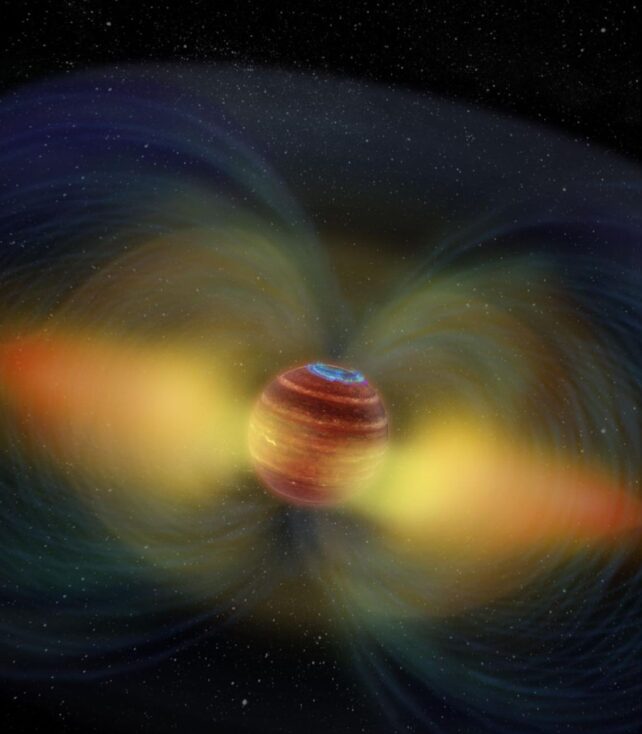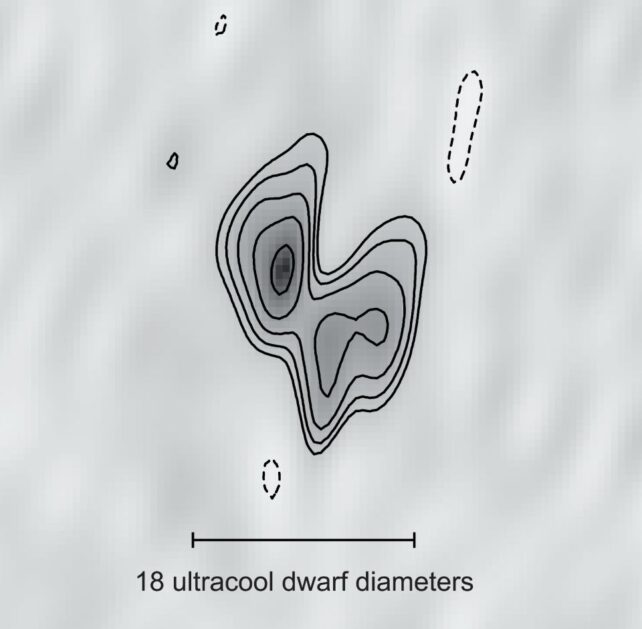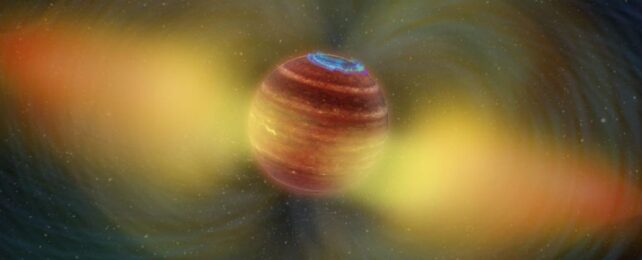All the planets in our Solar System with global magnetic fields have radiation belts, donut-shaped regions confined by magnetic fields where particles are trapped and accelerated, glowing in radio light. This all suggests that there should also be radiation belts wherever there is a stable, global magnetic field.
Detecting the faint emission from an extrasolar radiation belt is challenging, however, since that dim glow of a radiation belt is difficult to resolve. But challenging does not mean impossible: For the first time, astronomers have imaged a radiation belt wrapped around an extrasolar object.
That object is a very low-mass red dwarf star named LSR J1835+3259 that's just over the diameter of Jupiter, has about 77 times the mass of Jupiter, and sits some 20 light-years away.
"We are actually imaging the magnetosphere of our target by observing the radio-emitting plasma – its radiation belt – in the magnetosphere," says astronomer Melodie Kao of the University of California, Santa Cruz. "That has never been done before for something the size of a gas giant planet outside of our Solar System."

Earth has its Van Allen belts, filled with particles from the solar wind. Uranus, Neptune, Mercury, and Saturn all have radiation belts.
Jupiter's enormous radiation belts are predominantly supplied by volcanic moon Io as it coughs out great gouts of volcanic material. Even Jupiter's moon Ganymede – the only Solar System moon with its own magnetic field – has a sort of radiation belt.
And although the radiation belts and magnetic fields confining them had not been detected in extrasolar objects, we have seen clues of their presence.
Low-mass stars and brown dwarfs have exhibited activity similar to the auroras in the Solar System. Auroras – seen on multiple planets – are generated when accelerated charged particles are channeled along magnetic field lines to fall into a planet's atmosphere and interact with particles therein.
Having shown signs of this auroral activity (thus suggesting the presence of a global magnetic field), LSR J1835+3259 represented the perfect place to look closely for radiation belts.
Using a network of 39 radio telescopes across the globe to effectively create an Earth-sized radio telescope, Kao and her colleagues took observations of the star, looking carefully at the space around it, where a radiation belt, viewed from the side, would appear like two radio-emitting lobes.

Sure enough, images revealed a double-lobed structure around the star, emitting faint radio waves, similar to the lobes of Jupiter's radiation belt. However, because the star is much farther away than Jupiter, its radio lobes are much, much more intrinsically bright, around 10 million times brighter than Jupiter's.
And the radiation observed is a type that has been seen before in low-mass stars and brown dwarfs, but it had been attributed to flares in the stellar corona.
These findings not only confirm that objects such as stars can have radiation belts, but they also mean that we may have already seen radiation belts in other such objects and didn't know what we were looking at.
"Now that we've established that this particular kind of steady-state, low-level radio emission traces radiation belts in the large-scale magnetic fields of these objects, when we see that kind of emission from brown dwarfs – and eventually from gas giant exoplanets – we can more confidently say they probably have a big magnetic field, even if our telescope isn't big enough to see the shape of it," Kao says.
It's a result that astronomers hope will help search for potentially habitable worlds in the future as techniques and instruments are refined. That's because Earth's magnetic field is thought to be essential for life to flourish. It deflects harmful solar radiation from reaching the surface, protecting the atmosphere and the vulnerable organisms that inhabit the surface.
Tools that allow us to find magnetic fields around other worlds will help us find similarly protected planets.
That's still a bit of a way off, but this discovery puts us on the right path.
"This is a critical first step in finding many more such objects and honing our skills to search for smaller and smaller magnetospheres," says astronomer Evgenya Shkolnik of Arizona State University, "eventually enabling us to study those of potentially habitable, Earth-size planets."
The research has been published in Nature.
